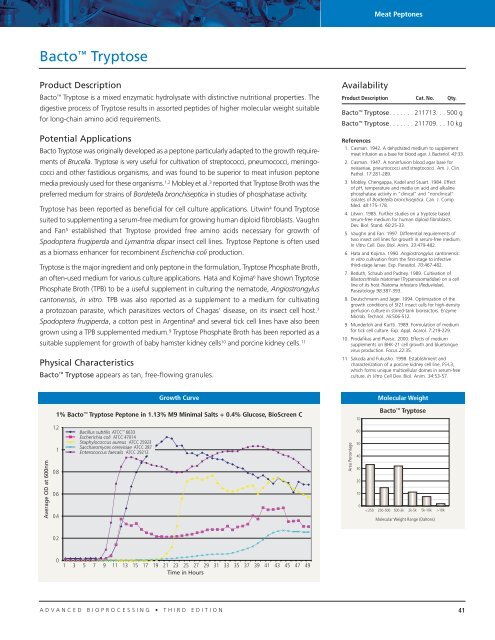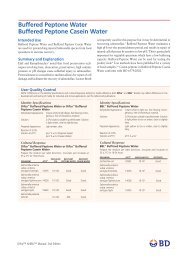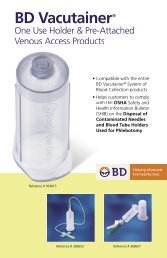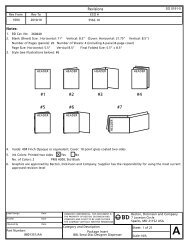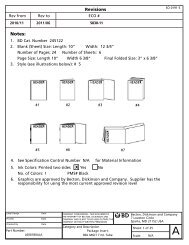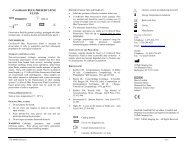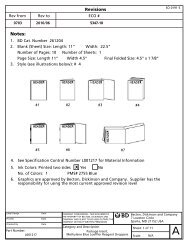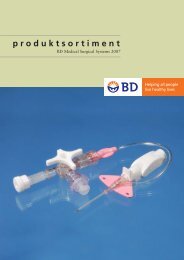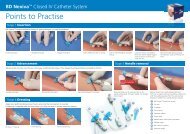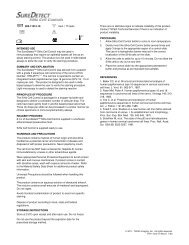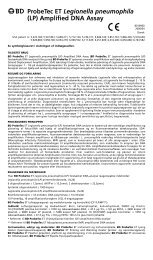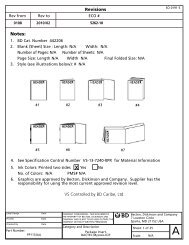Create successful ePaper yourself
Turn your PDF publications into a flip-book with our unique Google optimized e-Paper software.
Bacto Tryptose<br />
Product Description<br />
Bacto Tryptose is a mixed enzymatic hydrolysate with distinctive nutritional properties. The<br />
digestive process of Tryptose results in assorted peptides of higher molecular weight suitable<br />
for long-chain amino acid requirements.<br />
Potential Applications<br />
Bacto Tryptose was originally developed as a peptone particularly adapted to the growth requirements<br />
of Brucella. Tryptose is very useful for cultivation of streptococci, pneumococci, meningococci<br />
and other fastidious organisms, and was found to be superior to meat infusion peptone<br />
media previously used for these organisms. 1,2 Mobley et al. 3 reported that Tryptose Broth was the<br />
preferred medium for strains of Bordetella bronchiseptica in studies of phosphatase activity.<br />
Tryptose has been reported as beneficial for cell culture applications. Litwin4 found Tryptose<br />
suited to supplementing a serum-free medium for growing human diploid fibroblasts. Vaughn<br />
and Fan5 established that Tryptose provided free amino acids necessary for growth of<br />
Spodoptera frugiperda and Lymantria dispar insect cell lines. Tryptose Peptone is often used<br />
as a biomass enhancer for recombinent Escherichia coli production.<br />
Tryptose is the major ingredient and only peptone in the formulation, Tryptose Phosphate Broth,<br />
an often-used medium for various culture applications. Hata and Kojima6 have shown Tryptose<br />
Phosphate Broth (TPB) to be a useful supplement in culturing the nematode, Angiostrongylus<br />
cantonensis, in vitro. TPB was also reported as a supplement to a medium for cultivating<br />
a protozoan parasite, which parasitizes vectors of Chagas’ disease, on its insect cell host. 7<br />
Spodoptera frugiperda, a cotton pest in Argentina8 and several tick cell lines have also been<br />
grown using a TPB supplemented medium. 9 Tryptose Phosphate Broth has been reported as a<br />
suitable supplement for growth of baby hamster kidney cells10 and porcine kidney cells. 11<br />
Physical Characteristics<br />
Bacto Tryptose appears as tan, free-flowing granules.<br />
Average OD at 600nm<br />
1.2<br />
1<br />
0.8<br />
0.6<br />
0.4<br />
0.2<br />
0<br />
Bacillus subtilis ATCC 6633<br />
Escherichia coli ATCC 47014<br />
Staphylococcus aureus ATCC 25923<br />
Saccharomyces cerevisiae ATCC 287<br />
Enterococcus faecalis ATCC 29212<br />
Growth Curve<br />
1% Bacto Tryptose Peptone in 1.13% M9 Minimal Salts + 0.4% Glucose, BioScreen C<br />
1 3 5 7 9 11 13 15 17 19 21 23 25 27 29 31 33 35 37 39 41 43 45 47 49<br />
Time in Hours<br />
ADVANCED BIOPROCESSING • THIRD EDITION<br />
Availability<br />
Meat Peptones<br />
Product Description Cat. No. Qty.<br />
Bacto Tryptose. . . . . . . 211713. . . 500 g<br />
Bacto Tryptose. . . . . . . 211709. . . 10 kg<br />
References<br />
1. Casman. 1942. A dehydrated medium to supplement<br />
meat infusion as a base for blood agar. J. Bacteriol. 43:33.<br />
2. Casman. 1947. A noninfusion blood agar base for<br />
neisseriae, pneumococci and streptococci. Am. J. Clin.<br />
Pathol. 17:281-289.<br />
3. Mobley, Chengappa, Kadel and Stuart. 1984. Effect<br />
of pH, temperature and media on acid and alkaline<br />
phosphatase activity in “clinical” and “nonclinical”<br />
isolates of Bordetella bronchiseptica. Can. J. Comp.<br />
Med. 48:175-178.<br />
4. Litwin. 1985. Further studies on a tryptose based<br />
serum-free medium for human diploid fibroblasts.<br />
Dev. Biol. Stand. 60:25-33.<br />
5. Vaughn and Fan. 1997. Differential requirements of<br />
two insect cell lines for growth in serum-free medium.<br />
In Vitro Cell. Dev. Biol. Anim. 33:479-482.<br />
6. Hata and Kojima. 1990. Angiostrongylus cantonensis:<br />
in vitro cultivation from the first-stage to infective<br />
third-stage larvae. Exp. Parasitol. 70:467-482.<br />
7. Reduth, Schaub and Pudney. 1989. Cultivation of<br />
Blastocrithidia triatomae (Trypanosomatidae) on a cell<br />
line of its host Triatoma infestans (Reduviidae).<br />
Parasitology 98:387-393.<br />
8. Deutschmann and Jager. 1994. Optimization of the<br />
growth conditions of Sf21 insect cells for high-density<br />
perfusion culture in stirred-tank bioreactors. Enzyme<br />
Microb. Technol. 16:506-512.<br />
9. Munderloh and Kurtti. 1989. Formulation of medium<br />
for tick cell culture. Exp. Appl. Acarol. 7:219-229.<br />
10. Prodafikas and Plavsic. 2000. Effects of medium<br />
supplements on BHK-21 cell growth and bluetongue<br />
virus production. Focus 22:35.<br />
11. Sakoda and Fukusho. 1998. Establishment and<br />
characterization of a porcine kidney cell line, FS-L3,<br />
which forms unique multicellular domes in serum-free<br />
culture. In Vitro Cell Dev. Biol. Anim. 34:53-57.<br />
Area Percentage<br />
70<br />
60<br />
50<br />
40<br />
30<br />
20<br />
10<br />
0<br />
Molecular Weight<br />
Bacto Tryptose<br />
10k<br />
Molecular Weight Range (Daltons)<br />
41


